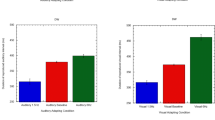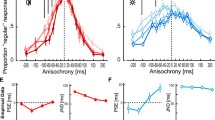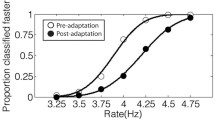Abstract
Forty subjects participated in an experiment designed to test the effects of different feedback displays on instructed heart rate speeding and slowing. One group of subjects received information about interpulse interval length every beat. This display included specific information about when systole occurred, in addition to information about performance relative to a criterion. Two other groups received similar information about performance, but their displays were not triggered by systole; rather, information about average interpulse interval was presented either every second or every 6 seconds. A fourth group of subjects participated in a perceptual motor task in which no instructions were given to control heart rate.
Results indicated that the instructed subjects generated significantly greater heart rate speeding than slowing. Groups receiving feedback produced greater changes when compared to the control group only during the speeding seassions. No differences among feedback groups were present in the slowing task. During speeding, the 1-second group's performance deteriorated dramatically in the second session. The results suggested that, in the context of a feedback task, it is information about the occurrence of systole that facilitates heart rate speeding. Real-time displays are less facilitating of heart rate change and may disrupt speeding performance when information is presented at certain “critical” frequencies. Slowing performance was again shown to be unrelated to information frequency or reinforcement rate.
Similar content being viewed by others
References
Blanchard, E. B., & Epstein, L. H.,A biofeedback primer. Menlo Park: Addison Wesley, 1978.
Cuthbert B. N., & Lang, P. J. Biofeedback and cardiovascular self-control.Scandinavian Journal of Behavior Therapy 1976,5 111–132.
Gatchel, R. J. Frequency of feedback and learned heart rate control.Journal of Experimental Psychology 1974,103 274–283.
Hill J. B. N., & Parr, G. (Eds.).Electroencephalography. New York: Macmillan, 1963.
Lang, P. J. Learned control of human heart rate in a computer environment. In P. A. Obrist, A. H. Black, J. Brener, & L. V. DiCara (Eds.),Cardiovascular psychophysiology. Chicago: Aldine, 1974.
Lang, P. J., & Twentyman, C. T. Learning to control heart rate: Binary vs. analogue feedback.Psychophysiology 1974,11 616–629.
Lang, P. J., & Twentyman, C. T. Learning to control heart rate: Effects of varying incentive and criterion of success on task performance.Psychophysiology 1976,13 378–385.
Twentyman, C. T. Three experiments on the effects of information frequency and feedback training on instructed heart rate speeding.Journal of Biological Psychology 1979,8 1–29.
Author information
Authors and Affiliations
Rights and permissions
About this article
Cite this article
Twentyman, C.T., Lang, P.J. Instructed heart rate control. Biofeedback and Self-Regulation 5, 417–426 (1980). https://doi.org/10.1007/BF01001357
Received:
Issue Date:
DOI: https://doi.org/10.1007/BF01001357




